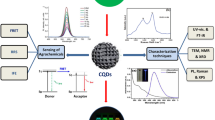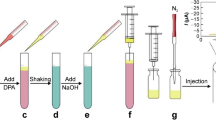Abstract
A method for intelligent data analysis was designed by combining electrochemical sensing with machine learning (ML). Specifically, a voltammetric sensor is described for determination of the phytoinhibitor maleic hydrazide in crop samples. Carboxyl-functionalized poly(3,4-ethylenedioxythiophene) (PEDOT-C4-COOH) was electro-synthesized in aqueous micellar solution by direct anodic oxidation of its monomer. A nanosensor was then prepared by placing copper nanoparticles (CuNPs) on the PEDOT-C4-COOH film via electro-deposition of Cu (II) from aqueous micellar solutions. An artificial neural network (ANN) served as a powerful ML model to realize intelligent data analysis and smart transformation for digital output. Different established regression methods were selected for evaluating the ANN-based method that was found to be superior to known methods. The sensor has a wide working range (from 0.06–1000 μM), a low limit of detection (10 nM), good stability, selectivity and practicality. The method was applied to the determination of maleic hydrazide in (spiked) samples of onion, rice, potato and cotton leaf. Satisfactory results demonstrate that the feature of simultaneous data acquisition and analysis is highly attractive.

Schematic representation of an electrochemical sensor based on carboxyl-functionalized poly(3,4-ethylenedioxythiophene) (PEDOT-C4-COOH) and copper nanoparticles (CuNPs) by differential pulse voltammetry (DPV) to detect maleic hydrazide (MH). PEDOT-C4-COOH was electro-synthesized in 0.1 M LiClO4 aqueous micellar solution with 0.1 M sodium dodecyl benzene sulfonate (SDBS) by amperometry (CA). CuNPs was prepared by cyclic voltammetry (CV).





Similar content being viewed by others

References
Fan CL, Xu JK, Chen W, Lu BY, Miao HM, Liu CC, Liu GD (2009) Polyfluorene derivatives with hydroxyl and carboxyl substitution electrosynthesis and characterization. J Phys Chem C 113:9900–9910
Wen YP, Xu JK (2017) Scientific importance of water-processable PEDOT-PSS and preparation, challenge and new application in sensors of its film electrode: a review. J Polym Sci Pol Chem 55:1121–1150
Elschner A, Kirchmeyer S, Lövenich W, Merker U, Reuter K (2010) PEDOT: principles and applications of an intrinsically conductive polymer, Boca, Raton
Jiang FX, Yue RR, Du YK, Xu JK, Yang P (2013) A one-pot ‘green’synthesis of Pd-decorated PEDOT nanospheres for nonenzymatic hydrogen peroxide sensing. Biosens Bioelectron 44:127–131
Richardson-Burns SM, Hendricks JL, Foster B, Povlich LK, Kim DH, Martin DC (2007) Polymerization of the conducting polymer poly(3,4-ethylenedioxythiophene) around living neural cells. Biomaterials 28:1539–1552
Wen YP, Xu JK, Liu M, Li D, Lu LM, Yue RR, He HH (2012) A vitamin C electrochemical biosensor based on one-step immobilization of ascorbate oxidase in the biocompatible conducting poly(3,4-ethylenedioxythiophene)-lauroylsarcosinate film for agricultural application in crops. J Electroanal Chem 674:71–82
Luo SC, Ali EM, Tansil NC, Yu HH, Gao SJ, Kantchev EAB, Ying JY (2008) Poly(3,4-ethylenedioxythiophene) nanobiointerfaces: thin, ultrasmooth, and functionalized PEDOT films with in vitro and in vivo biocompatibility. Langmuir 24:8071–8077
Zhang O, Yu HM, Lu LM, Wen YP, Duan XM, Xu JK (2013) Poly(thiophene-3-acetic acid)-palladium nanoparticle composite modified electrodes for supersensitive determination of hydrazine. Chinese J Polym Sci 31:419–426
Ramprasad R, Batra R, Pilania G, Mannodi-Kanakkithodi A (2017) Kim C, machine learning in materials informatics: recent applications and prospects. Npj Comput Mater 3:54
Butler KT, Davies DW, Cartwright H, Isayev O, Walsh A (2018) Machine learning for molecular and materials science. Nature 559:547–555
Zhu S, Li J, Ma L, He C, Liu E, He F, Shi C, Zhao N (2018) Artificial neural network enabled capacitance prediction for carbon-based supercapacitors. Mater Lett 233:294–297
Maleki N, Kashanian S, Maleki E, Nazari M (2017) A novel enzyme based biosensor for catechol detection in water samples using artificial neural network. Biochem Eng J 128:1–11
Zhang L, Wen YP, Yao YY, Xu JK, Duan XM, Zhang G (2014) Synthesis and characterization of PEDOT derivative with carboxyl group and its chemo/bio sensing application as nanocomposite, immobilized biological and enhanced optical materials. Electrochim Acta 116:343–354
Ying JY, Yu HH, Ali EM, Kantchev EAB (2010) US Patent:US0048815
Pardilla JA, Otero TF, Yu HH (2011) Electropolymerization and characterization of COOH-functionalized poly(3,4-ethylenedioxythiophene):ionic exchanges. Electrochim Acta 56:10238–10245
Lu Y, Wen YP, Lu BY, Duan XM, Xu JK, Zhang L, Huang Y (2012) Electrosynthesis and characterization of poly(hydroxymethylated-3,4 -ethylenedioxythiophene) film in aqueous micellar solution and its biosensing application. Chinese J Polym Sci 30:824–836
Wen YP, Xu JK, He HH, Lu BY, Li YZ, Dong B (2009) Electrochemical polymerization of 3,4-ethylenedioxythiophene in aqueous micellar solution containing biocompatible amino acid-based surfactant. J Electroanal Chem 634:49–58
Wen YP, Duan XM, Xu JK, Yue RR, Li D, Liu M, Lu LM, He HH (2012) One-step electrosynthesis of poly(3,4-ethylenedioxythiophene)-ethylsulfate matrix for fabricating vitamin C electrochemical biosensor and its determination in commercial juices. J Solid State Electrochem 16:3725–3738
Ali EM, Kantchev EAB, Yu H, Ying J (2007) Conductivity shift of polyethylenedioxythiophenes in aqueous solutions from side-chain charge perturbation. Macromolecules 40:6025–6027
Le WZ, Liu YQ (2009) Preparation of nano-copper oxide modified glassy carbon electrode by a novel film plating/potential cycling method and its characterization. Sens Actuat B 141:147–153
Jiang FX, Yao ZQ, Yue RR, Xu JK, Du YK, Yang P, Wang CY (2013) Electrocatalytic activity of Pd nanoparticles supported on poly (3, 4-ethylenedioxythiophene)-graphene hybrid for ethanol electrooxidation. J Solid State Electrochem 17:1039–1047
Bobacka J, Lewenstam A, Ivaska A (2000) Electrochemical impedance spectroscopy of oxidized poly(3,4-ethylenedioxythiophene) film electrodes in aqueous solutions. J Electroanal Chem 489:17–27
Wang CQ, Du J, Wang HW, Zou C, Jiang FX, Yang P, Du YK (2014) A facile electrochemical sensor based on reduced graphene oxide and au nanoplates modified glassy carbon electrode for simultaneous detection of ascorbic acid, dopamine and uric acid. Sensors Actuators B Chem 204:302–309
Wang HW, Wang CQ, Yang BB, Zhai CY, Bin D, Zhang K, Du YK (2015) A facile fabrication of copper particle-decorated novel graphene flower composites for enhanced detecting of nitrite. Analyst 140:1291–1297
Li SM, Yang BB, Wang J, Bin D, Wang CQ, Zhang K, Du YK (2016) Nonenzymatic electrochemical detection of rutin on Pt nanoparticles/graphene nanocomposite modified glassy carbon electrode. Anal Methods 8:5435–5440
Shibata M, Zuman P (1997) Electroreduction of the hydrazide of maleic acid in aqueous solutions. J Electroanal Chem 420:79–87
Ni YN, Qiu P, Kokot S (2004) Study of the voltammetric behaviour of maleic hydrazide and its determination at a hanging mercury drop electrode. Talanta 63:561–565
Sánchez A, Zapardiel A, Prado FLD (2007) E. Bermejo, M. Moreno, J.a. Pérez-López, M. Chicharro, flow injection analysis of maleic hydrazide using an electrochemical sensor based on palladium-dispersed carbon paste electrode. Electroanal 19:1683–1688
Fang YJ, Yan SL, Ning BA, Liu N, Gao ZX, Chao FH (2009) Flow injection chemiluminescence sensor using molecularly imprinted polymers as recognition element for determination of maleic hydrazide. Biosens Bioelectron 24:2323–2327
Zhang J, Xu JK, Wen YP, Wang ZF, Zhang H, Ding WJ (2015) Voltammetric determination of phytoinhibitor maleic hydrazide using PEDOT:PSS composite electrode. J Electroanal Chem 751:65–74
Acknowledgements
This work was supported by National Natural Science Foundation of China (51662014, 61502213), Outstanding Young Talent Program of Jiangxi Province (20171BCB23042). Natural Science Foundation of Nanchang City (2018CXTD014).
Author information
Authors and Affiliations
Corresponding authors
Ethics declarations
The author(s) declare that they have no competing interests.
Additional information
Publisher’s note
Springer Nature remains neutral with regard to jurisdictional claims in published maps and institutional affiliations.
Electronic supplementary material
ESM 1
(DOC 3699 kb)
Rights and permissions
About this article
Cite this article
Sheng, Y., Qian, W., Huang, J. et al. Electrochemical detection combined with machine learning for intelligent sensing of maleic hydrazide by using carboxylated PEDOT modified with copper nanoparticles. Microchim Acta 186, 543 (2019). https://doi.org/10.1007/s00604-019-3652-x
Received:
Accepted:
Published:
DOI: https://doi.org/10.1007/s00604-019-3652-x



